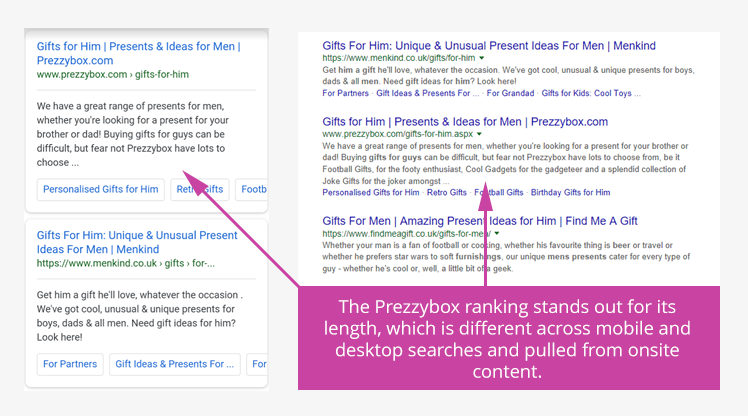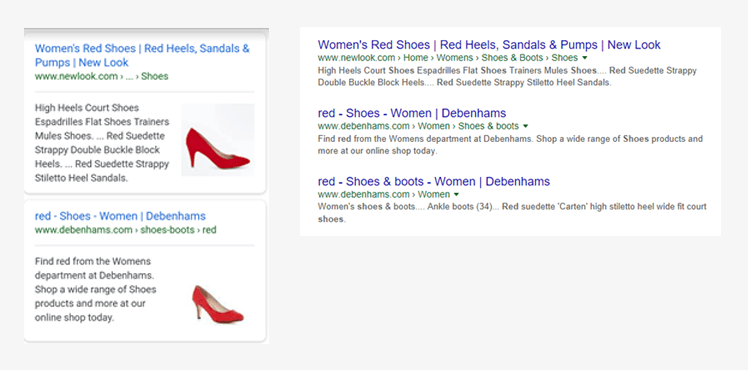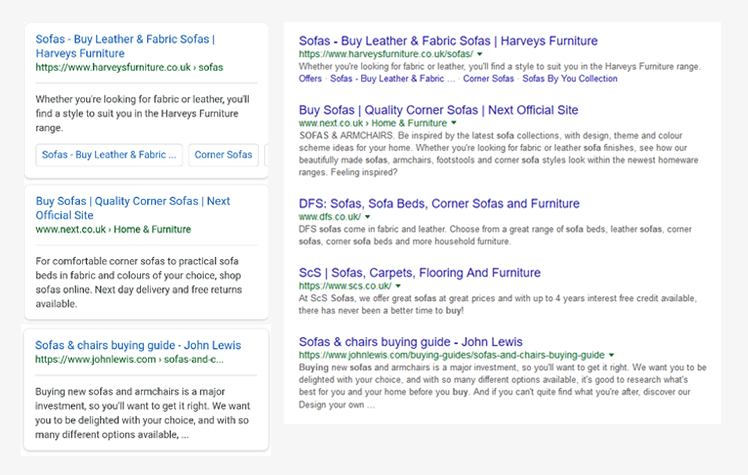At the end of 2017, Google officially announced that they were extending the amount of text visible in the description section for organic listings.

While this may seem a small change, it is actually one of the biggest shake-ups to a site’s organic search appearance in the last 10 years. In this post, we’ll unpack what the change means – and how to make the most of it.
Let’s start at the start…
Where Do Descriptions Come From?
The description in the search results – referred to by Google as a “snippet” – is the longer piece of text, in black, under the title and URL.

This text in the snippet can come from several places but is most typically drawn directly from a page’s coded meta description. Though meta descriptions are conceivably unlimited in length, the SEO concerns are (1) including the relevant keywords naturally to help search engines better understand the content of a page (2) writing copy that encourages the right audiences to follow the listing and engage with the site. As such, the guidance has always been to write meta descriptions of 150-160 characters so that it is fully displayed in Google’s snippet.
Google has always had the ability to write its own snippets for a page and will frequently rewrite snippets using onsite copy if it calculates that the result will be more relevant to a user’s search term. Though this has often been a simplistic science based on matching words on the page to a user’s query, our SEO trends explored the improvements in Google’s understanding of synonyms and context and the impact this will have for creating web content that secures top rankings.
What Does This Change Mean?
On one level, it means you can write longer meta descriptions to better tailor your SERP result to your audience – almost doubling from 160 to 300 characters. However, it also gives Google more freedom and space to tailor the snippets that it writes to a searcher’s needs.
While this is admirable for improving the search experience, Google has no sense of your brand or the tone of voice that you want to achieve and, quite often, the machine-generated descriptions are still nonsensical mash-ups of navigation elements, titles and onsite text.
It also means that each organic listing takes up more screen estate, going up to 4 lines on desktop. With the amount of non-organic results already pushing down the top 10, this change greatly increases the amount of scrolling and scanning for a searcher to work through the listings and may have a significant impact on the clickthrough rate for results ranking 5-10.
Another consideration is Google’s focus on mobile first indexing, which is slated to kick in properly 2018…
How does the New Meta Description Affect Mobile Users?
It is early days for this new development and very few sites are intentionally working to the new snippet limit. So, it is worth a few caveats that Google may change things further as people take advantage of the new limits.
However, it is already easy to see distinct differences between the mobile and desktop experiences that search marketers will have to consider. Following a range of tests, let’s investigate a few examples:
Test 1 – “Gifts for Men”
In this search for “gifts for men”, the Menkind snippets are both pulled straight from the meta description and clock in at a cool 153 characters. As a top ranking, it is enhanced by sitelinks in both mobile and desktop while the Prezzybox listing takes up more space and really stands out on the desktop version.
On both mobile and desktop, the Prezzybox snippet has been pulled from the site’s onsite content, ignoring the meta description entirely. While, the desktop version hits 338 characters, the mobile version has been truncated sooner, reduced to 189 characters – still 30 more than Menkind’s listing and pushing to a fifth line.

Conclusion 1 – Mobile snippets are longer than they were but are both different from desktops searches as well as shorter.
Conclusion 2 – Relevant snippets from meta descriptions will stay as they are; Google isn’t automatically pushing for the longer text.
Test 2 – “Red Shoes”
What is most interesting here is not the snippets, which are the same across desktop and mobile. In the text, New Look’s meta description has been ignored and Google has created its own snippet, most likely to include the word “red” more, and runs to 167 characters while Debenham’s 120 character meta is used as is.
The obvious difference is the images in the mobile results, drawn from products on the page. Both products are at different spots on the page, have non-optimised file names, and alt tags that describe them accurately.
How the choice of image was determined is a subject for a future blog but we can clearly see that on mobile the image compresses the text to the same long space we saw in the previous search results.

Conclusion 3 – Mobile snippets are experimenting with richer formats than desktop, which will also impact the limits of displayed text
Test 3 – “Buy Sofas”
Well folk, it doesn’t get more eCommerce than this! And we can see similar trends here as before:
- The Harveys snippet uses their short 109 meta description. The site has no further onsite text outside of navigation elements and product names.
- The Next mobile listing uses their 154-character meta description while the desktop listing is pulled from the first 329 characters of the onsite content, displaying the word “sofa” 5 times compared to just 3 on mobile – nice keyword stuffing, Google!
- Both John Lewis snippets ignore the site’s own tiny 32-character meta description (“Guide to buying sofas and chairs”) in favour of the much more informative onsite copy, using 329 characters on desktop and 179 on mobile, staying at four lines of text on mobile.

Conclusion 4 – Very short meta descriptions will be rewritten as usual but desktop rewrites may favour length in the aim of appearing more relevant.
Five Tips for Writing Meta Descriptions in 2018
Now that we understand more about why Google has implemented this change and how it affects different platforms, let’s look at how to move forward:
- Do not rewrite every meta description to use the full limit unless you are comfortable with having all your snippets truncated or rewritten by Google on mobile.
- Consider which platforms your customers are using to find, consider and buy from you and cater to that platform. If mobile is a key channel, keep your meta descriptions below 170 characters.
- Think of this new allowance as a bonus add-on to your current meta and use it to incorporate more natural synonyms and, above all, communicate the customer benefits of choosing your products or service. If you have free shipping, easy returns, a great brand story, pop it in the extra 100 characters to gain the screen estate and tell potential customers more about you.
- Review your onsite content and meta descriptions together and make sure you are using the greatest range of relevant keywords and variants across both, using Search Console to reveal long tail variants and then building audience focused language around them. Onsite text is key to Google’s self-generated snippets so make sure you’re using yours to its fullest potential.
- Remember your audience and make sure you follow our tips to write metadata that gets clicks.
Follow my contributions to the blog to find out more about marketing in a digital world, or sign up to the ThoughtShift Guest List, our monthly email, to keep up-to-date on all our latest guides, advice and blog posts.






